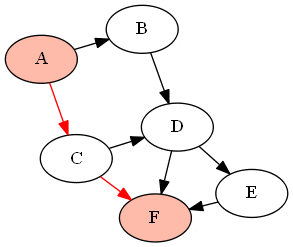我知道可能之前已经有人问过,但我找不到答案。 我需要修改下面的Dijkstra算法,它能够很好地找出2个节点之间的最短路径,但我还需要找到所有可能的路径。 我知道这应该相对容易做到,但到目前为止,我还不知道如何以最简单的方式做到这一点。我正在使用有向加权图。
class Dijkstra
{
private List<Node> _nodes;
private List<Edge> _edges;
private List<Node> _basis;
private Dictionary<string, double> _dist;
private Dictionary<string, Node> _previous;
public Dijkstra(List<Edge> edges, List<Node> nodes)
{
Edges = edges;
Nodes = nodes;
Basis = new List<Node>();
Dist = new Dictionary<string, double>();
Previous = new Dictionary<string, Node>();
// record node
foreach (Node n in Nodes)
{
Previous.Add(n.Name, null);
Basis.Add(n);
Dist.Add(n.Name, double.MaxValue);
}
}
/// Calculates the shortest path from the start
/// to all other nodes
public void calculateDistance(Node start)
{
Dist[start.Name] = 0;
while (Basis.Count > 0)
{
Node u = getNodeWithSmallestDistance();
if (u == null)
{
Basis.Clear();
}
else
{
foreach (Node v in getNeighbors(u))
{
double alt = Dist[u.Name] + getDistanceBetween(u, v);
if (alt < Dist[v.Name])
{
Dist[v.Name] = alt;
Previous[v.Name] = u;
}
}
Basis.Remove(u);
}
}
}
public List<Node> getPathTo(Node d)
{
List<Node> path = new List<Node>();
path.Insert(0, d);
while (Previous[d.Name] != null)
{
d = Previous[d.Name];
path.Insert(0, d);
}
return path;
}
public Node getNodeWithSmallestDistance()
{
double distance = double.MaxValue;
Node smallest = null;
foreach (Node n in Basis)
{
if (Dist[n.Name] < distance)
{
distance = Dist[n.Name];
smallest = n;
}
}
return smallest;
}
public List<Node> getNeighbors(Node n)
{
List<Node> neighbors = new List<Node>();
foreach (Edge e in Edges)
{
if (e.Origin.Equals(n) && Basis.Contains(n))
{
neighbors.Add(e.Destination);
}
}
return neighbors;
}
public double getDistanceBetween(Node o, Node d)
{
foreach (Edge e in Edges)
{
if (e.Origin.Equals(o) && e.Destination.Equals(d))
{
return e.Distance;
}
}
return 0;
}
public List<Node> Nodes
{
get { return _nodes; }
set { _nodes = value; }
}
public List<Edge> Edges
{
get { return _edges; }
set { _edges = value; }
}
public List<Node> Basis
{
get { return _basis; }
set { _basis = value; }
}
public Dictionary<string, double> Dist
{
get { return _dist; }
set { _dist = value; }
}
public Dictionary<string, Node> Previous
{
get { return _previous; }
set { _previous = value; }
}
}
}
static void Main(string[] args)
{
//Nodes initialisation goes here
Dijkstra d = new Dijkstra(_edges, _nodes);
d.calculateDistance(_dictNodes["A"]);
List<Node> path = d.getPathTo(_dictNodes["C"]);
}
